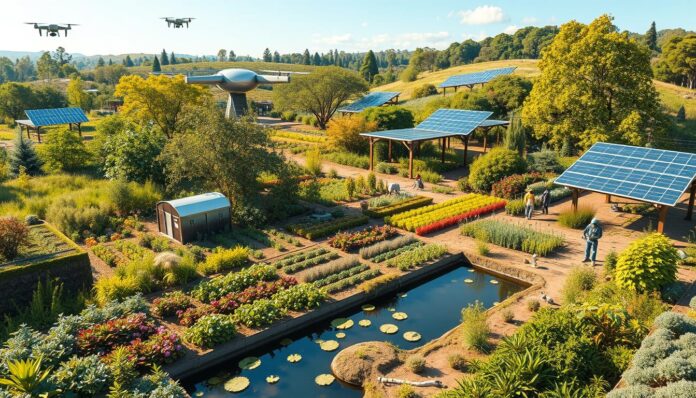Are robots the future of sustainable agriculture, or just a dream? Permaculture robotics is changing farming forever. It’s bringing a new way to grow food.
Precision farming is becoming a reality fast. New tech is linking nature with automation. This is opening up new chances for farming that’s good for the planet. Robots can now do hard farm jobs well, like watching over crops and planting them just right.
Robots in permaculture are a big step forward. They help farmers use resources better, save money, and grow more food. All this is done while keeping the environment safe.
Key Takeaways
- Robots can make farming better and more sustainable
- New farming tech is changing old ways of farming
- Automation can solve farm labor problems
- Robots can help reduce farming’s harm to the environment
- Innovation is key for growing food sustainably in the future
Introduction to Permaculture System Analytics
Permaculture is a new way to farm that’s better for the planet. It uses smart technology and works with nature. This changes how we farm and live with the environment.
At its heart, permaculture aims to design systems that are in sync with nature. It’s about making farms that are good for the earth and efficient. This way, we can grow food in a way that’s kind to our planet.
What is Permaculture?
Permaculture is a way to farm that’s based on nature. It has three main goals:
- Earth Care: Protecting and nurturing natural environments
- People Care: Supporting human communities and individual needs
- Fair Share: Reinvesting resources and limiting consumption
Significance of Analytics in Permaculture
Using data and smart tech makes permaculture better. It helps farmers use resources wisely and care for the earth. This makes farming more efficient and kinder to the planet.
“Permaculture is about creating sustainable human habitats by following nature’s intelligent design principles.” – Bill Mollison
Overview of Analytics Systems
Today’s permaculture uses the latest tech to improve farming. It includes:
- Sensor-based monitoring
- Machine learning algorithms
- Predictive ecological modeling
| Technology | Function | Ecological Impact |
|---|---|---|
| Autonomous Robots | Precision Crop Management | Reduced Chemical Usage |
| IoT Sensors | Real-time Environmental Tracking | Enhanced Resource Efficiency |
| AI Analysis | Predictive Agricultural Insights | Sustainable Decision Making |
By using these new methods, farmers can make their farms better. They become more productive and good for the environment.
Benefits of Using Analytics in Permaculture
Permaculture analytics change the game for sustainable farming. They mix smart farming with data insights. This way, farmers can use resources better and care for the environment more effectively.
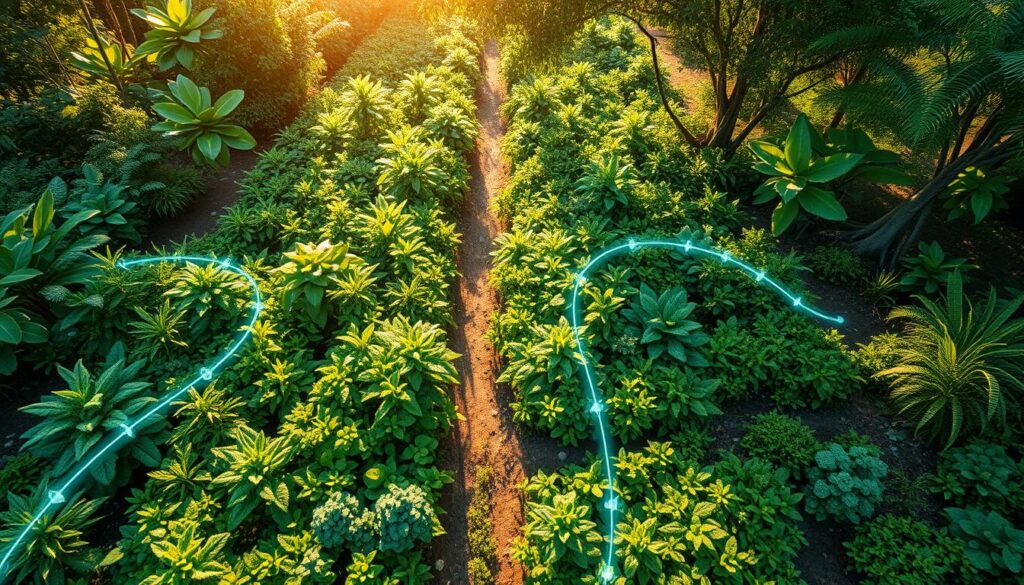
Improved Resource Management
Analytics make farming better at using resources. By tracking data closely, farmers cut down on waste. This makes their farms more efficient.
- Soil erosion reduction up to 50%
- Water retention improvement by 15-30%
- Chemical usage reduction potential of 95%
Enhanced Decision-Making
Analytics and nature’s wisdom help farmers make smart choices. They can watch their farms in real-time. This lets them manage their land like nature does.
“Data transforms agriculture from reactive to predictive management” – Sustainable Agriculture Research Institute
Increased Sustainability and Resilience
Analytics help farms be stronger and more sustainable. By knowing how ecosystems work, farmers can build farms that do well even when things get tough.
| Metric | Improvement |
|---|---|
| Carbon Sequestration | 20% increase |
| Local Food Production | 50% supply chain independence |
| Community Resource Sharing | 40% enhancement |
Analytics in permaculture is a game-changer for farming. It gives farmers deep insights into managing their land and resources.
Key Components of Permaculture System Analytics
Permaculture system analytics is a new way to make farming better. It uses smart technology to improve how we farm. This makes farming more efficient and better for the environment.
Today’s permaculture uses advanced data collection. This lets us see how farms work in new ways. Robot-plant interaction has changed how we check on crops and the environment.
Data Collection Methods
- Advanced sensor networks for real-time environmental monitoring
- Drone-based aerial imaging for comprehensive crop assessment
- Robotic systems performing plant-by-plant health tracking
- Satellite imagery for large-scale landscape analysis
Analytical Tools and Software
New software uses artificial intelligence to understand farm data. It turns complex data into useful information. This helps farmers make better choices about their crops and resources.
| Technology | Function | Efficiency Improvement |
|---|---|---|
| AI-Driven Analytics | Predictive Crop Health | 40-60% Accuracy Increase |
| Autonomous Monitoring Systems | Resource Management | Up to 50% Resource Optimization |
| Machine Learning Algorithms | Yield Prediction | 30-45% Forecasting Precision |
Performance Metrics
Permaculture analytics looks at more than just how much is grown. It checks biodiversity, how well resources are used, and how strong the ecosystem is.
“The future of agriculture lies in understanding complex ecological interactions through data-driven insights.” – Permaculture Innovation Research Center
By using these new methods, farmers can make their farms better. They can make farming more sustainable, productive, and strong. This combines technology with nature’s ways.
Role of Data Visualization in Permaculture
Data visualization is key in smart farming, turning complex data into clear insights. It helps farmers understand environmental patterns and make better choices.
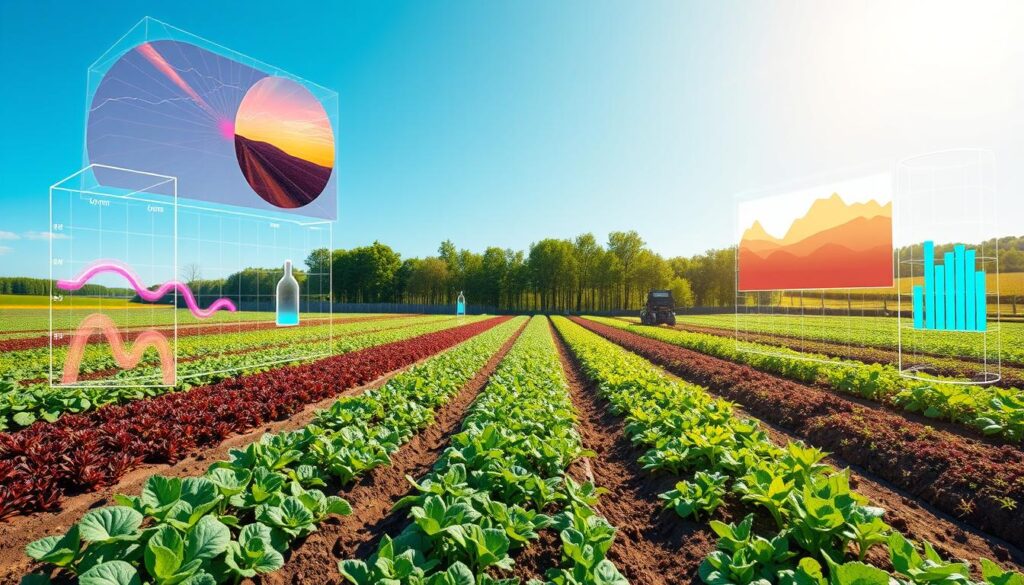
In eco-friendly technology, data visualization connects raw data to smart management. It turns complex data into easy-to-understand visuals. Farmers can then quickly see important info about crops, resources, and the environment.
Types of Data Visualization Tools
- Geographic Information Systems (GIS)
- Interactive Dashboards
- Real-time Crop Monitoring Platforms
- Satellite Imagery Analysis Tools
Benefits of Visualization
Visualization offers many benefits in permaculture:
- It helps spot patterns easily.
- It makes complex data simple to share.
- It speeds up decision-making.
- It improves how resources are used.
Case Studies in Data Visualization
The AI system ‘WILMA’ shows the power of data visualization in farming. WILMA uses crop data to give farmers exact care tips, showing how it can change farming.
“Data visualization turns numbers into stories, helping farmers get the big picture of their ecosystem.” – Agricultural Innovation Expert
As farming faces big challenges, with only 60 years of fertile land left, data visualization is vital. It’s a key part of sustainable farming.
Implementing Analytics in Permaculture Design
Permaculture design is changing with new analytics. This is making agriculture more regenerative and autonomous. New technologies are changing agroecology practices. They help farmers make better, more sustainable choices.
Today’s permaculture experts use advanced tools to improve farming. They use data to manage resources better and protect the environment.
Step-by-Step Implementation Process
- Conduct comprehensive site analysis
- Identify key performance metrics
- Select appropriate analytical tools
- Collect baseline environmental data
- Develop monitoring strategies
Tools for Analytics Integration
| Technology | Application | Potential Impact |
|---|---|---|
| IoT Sensors | Real-time soil monitoring | 20% crop yield increase |
| Drone Mapping | Precision crop assessment | Enhanced spatial analysis |
| Machine Learning | Predictive crop health | Early disease detection |
Overcoming Implementation Challenges
Adding analytics to permaculture design faces several hurdles:
- Data integration complexity
- Technology adoption barriers
- Cost of advanced monitoring systems
*The future of agriculture lies in understanding ecological systems through intelligent data collection and analysis.*
By using these new technologies, permaculture experts can make farming more sustainable. They can create systems that work well with nature.
Evaluating Permaculture System Performance
Sustainable agriculture needs strong ways to track and boost farm performance. Precision farming has changed how we measure and improve agricultural systems, like in permaculture design.
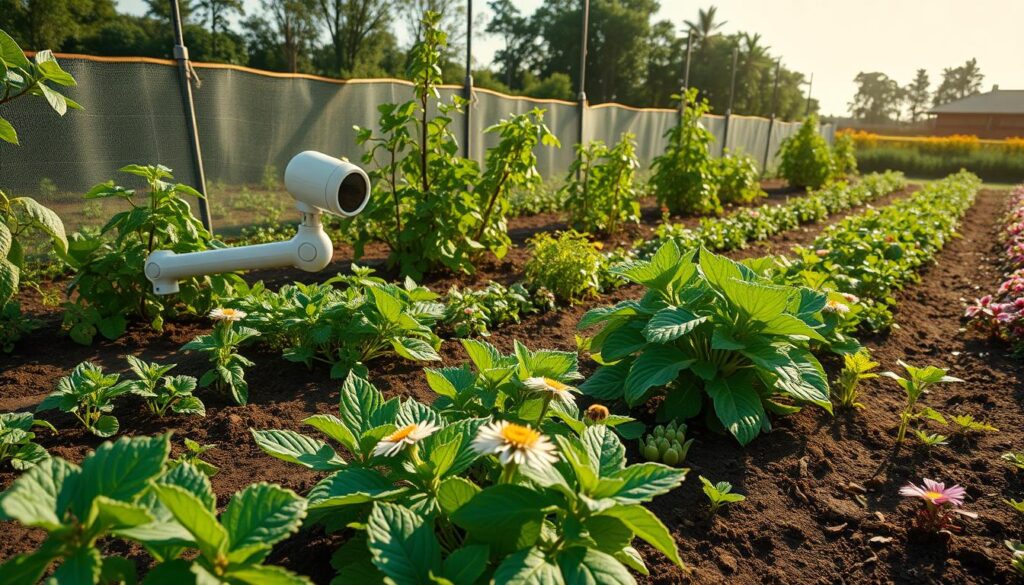
Success in permaculture systems comes from analyzing many performance indicators. Smart farming lets farmers watch key metrics that show their farm’s health and productivity.
Key Performance Indicators in Permaculture
- Biodiversity index
- Soil health metrics
- Resource use efficiency
- Crop yield and quality
- Water conservation rates
Methods for Continuous Improvement
Good permaculture management needs flexible strategies. Farmers can use data to:
- Keep improving their designs
- Watch how ecosystems work together
- Change how they grow crops
- Use resources better
Case Studies of Successful Evaluations
Studies show how important analytics are in sustainable farming. For example, farms using precision farming have seen big gains:
By using data, some permaculture systems have boosted crop yields by up to 30% while cutting down on environmental harm.
Looking at the numbers, we see good signs for farm performance checks. With only about 5% of farmers using automated tools, there’s a lot of room for growth in smart farming.
The future of permaculture depends on our ability to measure, understand, and keep improving farms with advanced analytics.
Challenges in Permaculture Analytics
The growth of permaculture robotics and eco-friendly tech brings big challenges. As farming gets automated, farmers face tough issues with data and tech use.
Data Quality and Reliability Concerns
Keeping data accurate in permaculture analytics is a big challenge. Sensors and systems must work well in changing environments. Key problems include:
- Inconsistent sensor performance in diverse ecological settings
- Signal interference from environmental factors
- Calibration difficulties in complex agricultural ecosystems
Accessibility of Analytical Tools
Using eco-friendly tech in permaculture is hard because of big barriers. High costs and tech complexity stop many from using advanced tools.
| Challenge | Impact | Potential Solution |
|---|---|---|
| High Software Costs | Limited Small Farm Adoption | Open-source Platforms |
| Complex User Interfaces | Reduced User Engagement | Simplified Design |
| Technical Training Requirements | Skill Gap Barriers | Community Training Programs |
Skills Gap in Analysis Techniques
Learning about permaculture robotics needs special skills. But, schools often can’t teach these. Bridging this skills gap is key for farming’s future.
“The future of agriculture lies in our ability to integrate technological expertise with ecological understanding.” – Sustainable Agriculture Research Institute
To solve these problems, we need teamwork from tech experts, farmers, and schools. Together, we can make farming tech more accessible and effective.
Integrating Local Knowledge with Analytics
Sustainable agriculture grows when old wisdom meets new tech. Permaculture design is a key way to mix community knowledge with data. This creates strong, eco-friendly farming systems that fit local needs.
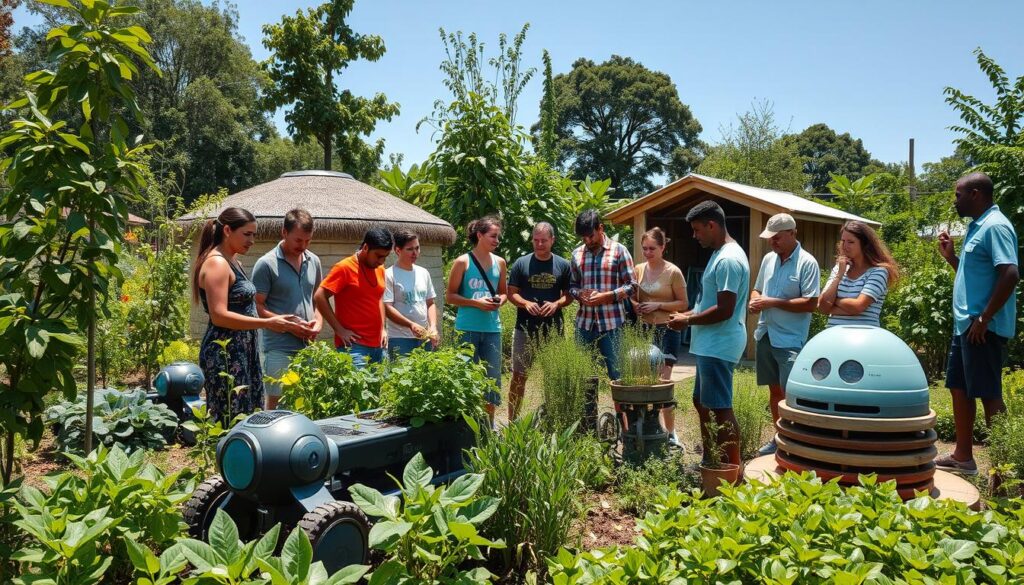
Combining local wisdom with analytics opens up big chances for agroecology. Communities know the land in ways tech can’t match.
Importance of Community Input
Local farmers offer unique views on sustainable farming. They know a lot, including:
- How the land changes in small ways
- Old ways of rotating crops
- How to fight pests the natural way
- When to plant based on the seasons
Balancing Traditional Practices with Analytics
Biomimicry teaches us to mix tech with nature’s wisdom. Using data can make traditional farming better and stronger.
“Our greatest agricultural innovations emerge when we listen to both data and traditional wisdom” – Ecological Research Network
Case Studies of Integration
Permaculture projects show how local wisdom and data work together. This mix leads to farming that’s good for the planet and respects local culture.
By using community knowledge and data tools, farmers can make farming better. It becomes more productive, eco-friendly, and strong.
Future Trends in Permaculture Analytics
The world of farming is changing fast thanks to new tech. Permaculture robotics and smart farming are making farming more sustainable. They offer new ways to farm with precision.
Artificial intelligence, machine learning, and advanced sensors are creating new tools for farming. Farmers can now use advanced analytics to improve their farms. This is done with great accuracy.
AI and Machine Learning Applications
AI is changing how we manage permaculture in two main ways:
- Generative AI for new permaculture designs
- Iterative control systems for day-to-day management
- Predictive modeling for planning crop rotations
- Advanced ways to manage pests
“Technology is transforming agriculture from traditional practices to data-driven ecological systems.” – Agricultural Innovation Expert
Impact of Remote Sensing Technologies
Now, precision farming uses advanced tech like hyperspectral imaging and LiDAR. These tools help farmers:
- Spot small changes in crop health
- Improve how they water their crops
- See potential environmental problems
Evolving Data Privacy Regulations
As farming tech gets better, keeping data safe is more important. New rules are coming to protect farmers’ data while still allowing for tech progress.
About 70% of farmers are using automation, spending $450,000 to $500,000 a year. The future of permaculture analytics looks bright and full of new tech.
Educational Resources for Permaculture System Analytics
Exploring educational pathways is key for those into sustainable agriculture and regenerative design. Permaculture system analytics offers many learning chances. It connects eco-friendly tech with real-world knowledge.
Online Courses and Certifications
Online learning sites now offer deep training in sustainable agriculture analytics. Students can find courses on:
- Data collection in permaculture systems
- Advanced tools for ecological design
- Regenerative design principles
- Using tech in farm management
“Learning is the cornerstone of transformative ecological practice” – Permaculture Design Collective
Workshops and Conferences
Hands-on learning is still crucial for gaining practical skills in permaculture analytics. Key events include:
- Annual Permaculture Technology Symposium
- Regenerative Agriculture Conference
- Sustainable Design and Analytics Workshop
Recommended Books and Publications
For deep knowledge, many books offer insights into eco-friendly tech and sustainable farming:
- Permaculture Analytics: A Comprehensive Guide by Sarah Green
- Data-Driven Ecological Design by Michael Rodriguez
- Sustainable Agriculture in the Digital Age by Dr. Elena Martinez
These resources help people develop advanced skills in permaculture analytics. They mix traditional ecological knowledge with modern tech.
Collaboration and Networking in Permaculture Analytics
The world of permaculture is changing fast. It’s thanks to new tech and green farming methods. Working together and sharing ideas are key to improving permaculture robotics and smart farming.
By teaming up, we’re changing how we do agroecology. People from different fields are coming together. They’re sharing knowledge and creating new solutions.
Building a Community of Practice
To build a strong community, we need to:
- Make online spaces for sharing knowledge
- Have regular online and in-person meetings
- Start joint research projects
- Support open-source tech projects
Sharing Best Practices
“Innovation thrives when knowledge is freely exchanged” – Permaculture Innovation Network
To share knowledge well in permaculture analytics, we should:
- Write down how to do things right
- Make learning materials easy to find
- Host workshops and webinars
- Build libraries of success stories
Establishing Partnerships
Forming strong partnerships is vital for permaculture tech progress. Working together between schools, tech firms, and local groups speeds up innovation in smart farming and permaculture robotics.
The FarmBot project shows what’s possible with teamwork. It has over 90 countries using its kits and more than 500 schools adopting its tech.
Policy Implications and Support for Permaculture Analytics
The world of sustainable agriculture is changing fast. Policy plays a big role in pushing innovation and supporting green tech. Governments around the globe see the big impact of precision farming on the environment.
Policymakers are coming up with plans to encourage farming that’s good for the planet. They use different ways to do this:
- Financial grants for sustainable agriculture research
- Tax incentives for using precision farming tech
- Subsidies for green tech investments
Government Incentives for Sustainable Practices
The United States Department of Agriculture is a big supporter of sustainable farming. Studies show that the right policies can really cut down on harm to the environment.
| Policy Area | Potential Impact | Technology Focus |
|---|---|---|
| Research Funding | 95% Reduction in Chemical Usage | Precision Farming Tools |
| Technology Grants | 90% CO2 Emissions Reduction | Robotic Agricultural Systems |
Role of NGOs in Promoting Analytics
Non-governmental organizations are key in filling tech gaps. They offer training, tech access, and places for sharing knowledge in sustainable farming.
“Collaborative efforts between government, NGOs, and agricultural communities are essential for sustainable technological transformation.”
Impact of Environmental Regulations
Environmental rules are shaping precision farming. They set standards for sustainable practices and green tech. This helps reduce harm to nature.
Using advanced analytics in permaculture is a big step forward. It promises more sustainable and efficient ways to grow food.
Case Studies in Successful Permaculture Analytics Applications
Permaculture analytics has changed sustainable farming with new tech and smart designs. It uses permaculture robotics and systems to help farmers and city planners. They are making new ways to design for a better future.
Urban Permaculture Success Stories
Urban areas are changing fast with data-driven permaculture plans. New urban farming projects are making farms more productive and green.
- Smart vertical farming systems increase crop yields by 30%
- Autonomous irrigation cuts water use by 25%
- AI pest control lowers chemical use by 20%
Agricultural Innovations
New permaculture robots are changing farming. They work all the time, making farms more efficient and productive.
| Technology | Productivity Impact | Resource Efficiency |
|---|---|---|
| Autonomous Farming Systems | 20% Yield Increase | 30% Water Conservation |
| AI Crop Monitoring | 15% Prediction Accuracy | 90% Targeted Pest Control |
Community-Led Projects
Local groups are working together on permaculture projects. They use tech and community ideas to make a difference.
“Technology enables us to work smarter, not harder, in creating sustainable agricultural ecosystems.”
Using tech and data, we’re making farming better. It’s a step towards more sustainable and productive farming.
Tools for Analytics in Permaculture Management
The world of smart farming is changing fast. New precision farming tools are changing how we manage farms. Now, we have better ways to farm that are good for the planet.
Today, permaculture needs advanced analytics tools. These tools help farmers make smart choices based on data. They give insights into how crops grow, how to use resources, and how to care for the environment.
Software Recommendations for Permaculture Analytics
New software is changing how we manage farm data. Farmers can now use powerful tools. These tools combine data from:
- Soil health monitoring systems
- Crop yield prediction algorithms
- Water resource optimization platforms
- Climate adaptation tracking software
Mobile Apps for Precision Data Collection
Mobile apps are changing how we collect data on farms. These apps let farmers check data in real-time. This helps them make quick decisions.
Open-Source Alternatives in Agricultural Analytics
Open-source tools are making advanced analytics available to all. These tools can be tailored to fit any farm’s needs. They help both small and big farms.
“Technology is the bridge between traditional farming wisdom and modern sustainable practices.” – Agricultural Innovation Expert
Using data to guide farming has shown great promise. Studies show it can boost crop yields by 20%. It also cuts down on waste and harm to the environment.
| Technology Type | Key Benefits |
|---|---|
| Sensor Networks | Real-time crop and soil monitoring |
| Predictive Analytics | Improved resource management |
| Mobile Applications | Instant data collection and analysis |
The future of permaculture is all about using these new tools. It’s about turning old farming ways into something modern and green.
Conclusion and Future Directions in Analytics for Permaculture
The world of sustainable agriculture is changing fast, thanks to permaculture robotics. Studies show that using advanced tech in farming can be very effective. Tools like precision farming and sustainable agriculture practices are leading to better farming methods.
Digital farming tools are changing how we grow crops and care for the environment. New technologies like climate-smart farming and IoT are combining tech with nature’s wisdom. Biomimicry is helping create smarter farming systems.
The future of permaculture needs to use new tech while keeping nature’s balance. Farmers and researchers must get better at using digital tools. Technologies like GPS and yield monitors help farms grow more with less harm to the environment.
Looking ahead, using permaculture robotics and sustainable farming is key to solving world hunger and environmental issues. We must keep improving tech, teach farmers about digital tools, and focus on farming that’s good for the planet.

